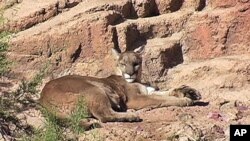The Arizona-Sonora Desert Museum in the (U.S. western) city of Tucson, Arizona is like no other in the world. It's a zoo, botanical garden and research organization. Most of the museum is outdoors and showcases plants and animals that live in the Sonoran desert, located in parts of Arizona, California and Mexico. The animals look like they're in the wild, but most are screened off from visitors by invisible means.
The mountain lion is the largest cat native to North America. A solitary and nocturnal animal, it is not often seen in the wild. But here, at the Arizona-Sonora Desert Museum, it appears to be in its natural environment, not an exhibit. This realistic looking canyon is made from molds of boulders using concrete and metal rods.
More than 300 animal species and 1200 types of plants are found along 3 kilometer-long paths. They include the endangered Mexican Wolf and giant Saguaro cactus. Visitors have the feeling of walking in the desert surrounded by native plants and wildlife.
"The Sonoran Desert region is a very special place," said Craig Ivanyi, director of exhibits. "It's the lushest desert on the planet," he explains, "Instead of being in an urban environment, you're immersed in the desert we represent."
More than half a million people visit the museum each year.
Jane Hiya is from Canada. "Oh, I think it's simply amazing," she said. "It looks very natural and there's so much variety here that I've never seen before."
There are many coyotes in Arizona. This one looks like it is in the open, instead of contained by a mesh fence.
"All of the exhibits are designed with barriers, moats, walls or fencing, quite often fencing that's difficult for visitors to see," Ivanyi said.
Some exhibits have glass viewing areas, like for the prairie dog. It's not a dog, but a rodent that lives in underground tunnels.
Other exhibits showcase the bobcat, a pig-like creature called a javelina and the black bear, the only bear species in Arizona.
Typical desert creatures such as scorpions and snakes are also on display, as well as animals that live in water like frogs, and otters that burrow under rocks and logs.
Birds are everywhere, both in captivity and in the wild. Each day, a demonstration is held to show birds of prey in flight. Birds like this Harris Hawk can fly where they want to, but have been trained to come back for food.
Bird Trainer Dillon Horger says the birds don't fly away because they consider the Desert Museum their territory.
"They want to come back with us, they want to go back into their enclosures, and spend the night in a safe, secure area where they know they get food and water and shelter," Horger said.
Ivanyi hopes the Desert Museum will inspire people to protect the Sonoran desert. "So they're aware of what kinds of plants and animals are out there," he said, "and hopefully, give them some sort of passion for wanting to save it."





